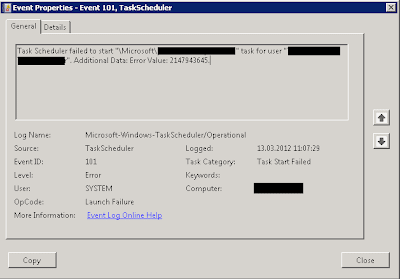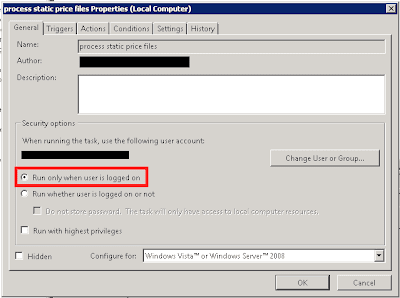
by community-syndication | Mar 13, 2012 | BizTalk Community Blogs via Syndication
We have a script scheduled using the Task Scheduler. Now we realised however that the script hadn’t run for a while.
when analyzing the scheduled task, we couldn’t find any issue… the task was currently running.
However, when we reveiwed the history of the task we noticed there was an error each time it tried to run the task.
The error just said : ‘Task Scheduler failed to start “YourScript” task for user “yourUser“. Additional Data: Error Value: 2147943645.’
The error message doesn’t say much useful. But what does it mean?
Turned out the solution was quite simple: it just means you are trying to run a job with the “Run only wheb user is loffed on” flag set.
This also explains why the job was running succesfully when we checked the task, since we were logged in as the configured user. A real simple solution for a meaningless error message.
by community-syndication | Mar 12, 2012 | BizTalk Community Blogs via Syndication
Software pricing is always tricky, it’s all about how much someone is willing to pay for your product rather than what it cost to produce and support. Most of the time it’s either rolling the dice or finger in the air estimate.
At BizTalk360 we didn’t quite do it that way, instead we conducted a survey with around 200 people in the BizTalk area giving them 3 simple choices (Free, $1-$5k, $5 -$10k and over $10). Majority of them suggested between $5-$10k and we opted for our current pricing model with some more thoughts on standard and enterprise BizTalk editions.
At that time we quite didn’t understand the whole enterprise software business, challenges around and real hurdles. Now after dealing with customers across the world we know exactly how the model works.
Changing the pricing could have serious impact on the product, hence we want to engage with the community and get your thoughts. I’ll present the list of challenges we are facing
1. Closing a deal takes a long period.
BizTalk360 is an enterprise product, it’s not mobile app where people see it – buy it instantaneously. They download the BizTalk360 trial to do their due diligence, lots and lots of email communications (over 50 emails is very common). May be 5-10 phone calls, May be 1 or 2 live demos, in some case it’s client site visit and POC.
At an average we spend easily 10-20 hours over a period of 4 to 10 weeks before we can on-board a customer. That’s lot of hours. We are happy to answer all those question, but I guess that should reflect on the price.
2. Commercial side paper work, legal charges and insurance cost
Once we cross the technical challenges boundary and they are convinced with the product, the commercial teams will get in touch with us with set of paper work. Typically a NDA, Confidentiality, Eval Terms Agreement, Vendor registration, W9 Tax stuff, Vendor license agreement etc. You just can’t simply glance through it and sign it, it may have some nasty surprises in small print some where hidden deep inside, one such example
“Supplier shall pay any and all damages, awards, fees, costs, and expenses associated therewith, including without limitation, any amounts paid in settlement thereof and reasonable attorneys fees.”
So, we reached a stage where we can’t just do it ourselves and we need to involve legal teams. It’s not a surprise to anyone, involving a legal person is not cheap.
In addition to legal fees, this also brings us to a new set of expenses called “Product liability insurance” and they are not cheap.
3. Reseller commission
Lot of the organisations won’t purchase the software directly for various reasons (paper work as explained in the previous block is an example). The software will be purchased through a reseller. I don’t need to explain the nature of the whole middle man business whether you are buying a house or looking for your pension. They need a slice, possibly from both sides. But they definitely ask us, anywhere in the region of 5-10%
4. Having a fair price, sometimes make the product look cheap
This is a funny one, the perception is still there. If you software is not 10’s of thousands of $$$ people assume it’s not going to do it’s job properly. We priced BizTalk360 very, very fairly. Our objective was to build something that’s super useful and provide it to wide audience with a fair price, just making sure we can make a living out of it. Recently we had a customer visit, huge BizTalk implementation, 6 servers, with 24 BizTalk licenses. Approximately over $500k just on licensing cost for the environment and when we quote around $5k for our software for that environment, it just make them wonder “does it actually work!!”. I just want to assure everyone who got this doubt in mind, we put incredible amount of effort to build BizTalk360 to enterprise quality. We are not Jo bloke’s, we got incredible track record in what we are doing.
5. Partner commission
For us this is ok, because we sign up partners agreeing terms and conditions upfront, they bring us business and we are happy to provide them their share. But need to keep this in mind when it comes to pricing our product.
6. Exchange rates and Bank commissions
We are based in UK, ? is not treated as international currency. Software products are normally traded in USD ($) especially if you are targeting global market. That brings another expense to your enterprise software i.e the money lost in bank exchange rates and bank commissions. If the customer does a bank wire transfer, the fees will be around 1 to 1.5%, if you are processing via online payment gateway like PayPal or some other internet merchant accounts, then it will range anywhere between 2.5 to 5%
7. BizTalk360 has grown significantly
The current pricing was published all most a year ago with Version 1.0 of the product. Now BizTalk360 is in version 3.2 (2.5, 3.2), with each version we brought really exciting features. The more features we add, it means more areas to maintain and support.
We need your input
As I mentioned pricing a software is tricky and changing the pricing is even more tricky, we need your thoughts and input how we should do it
1. Is $5299 for whole BizTalk environment in spite of the number of servers/CPU’s still a fair price
2. Is $1324 for whole test environment fair price?
3. Is changing the pricing going to upset people?
Note: We are very happy with Standard license cost for BizTalk server standard users at $1324, given they are only going to pay around $10k for their BizTalk license.
Please respond back with your comments, or if you want to respond privately please drop us a line at contact(at)biztalk360.com
Nandri!
Saravana Kumar
by community-syndication | Mar 9, 2012 | BizTalk Community Blogs via Syndication
I’m finally back home after a great trip to Seattle and to see some fellow VTSPs from
all over the globe. Very switched on bunch.
I was fortunate enough to be asked to present and with Scotty at
the demo controls, we steered a pretty good session.
Thanks to ’all y-all’ whom was in the session and I hope you got as much out of it
as I did.
Grab the Public Version of the slide Deck – HERE.
So as promised on the advice of John Brockmeyer here’s some current limitations of
the Azure ’Integration’ Services.
Blog Post by: Mick Badran

by community-syndication | Mar 9, 2012 | BizTalk Community Blogs via Syndication
When using ESB Toolkit’s Exception Management WCF service in .NET Applications to submit faults to the Esb Management Portal. You might see the below errors in the event log of the server where BizTalk and Esb Toolkit are installed
“A message sent to adapter “SQL” on send port “ALL.Exceptions” with URI “SQL://<server name>/EsbExceptionDb/” is suspended.
Error details: There was a failure executing the send pipeline: “Microsoft.Practices.ESB.ExceptionHandling.Pipelines.ESBFaultProcessor, Microsoft.Practices.ESB.ExceptionHandling.Pipelines, Version=2.1.0.0, Culture=neutral, PublicKeyToken=31bf3856ad364e35” Source: “ESB BAM Tracker” Send Port: “ALL.Exceptions” URI: “SQL://<servername>/EsbExceptionDb/” Reason: Error 125006: The BAM Activity Id could not be found in the Fault message using the xpath : xpath
MessageId: {7D272E10-5655-4063-8D70-D1AB6ABBFDE9}
InstanceID: {B65710D2-2F2B-4A4F-A38B-77F90978E1F8}“
and
“There was a failure executing the send pipeline: “Microsoft.Practices.ESB.ExceptionHandling.Pipelines.ESBFaultProcessor, Microsoft.Practices.ESB.ExceptionHandling.Pipelines, Version=2.1.0.0, Culture=neutral, PublicKeyToken=31bf3856ad364e35” Source: “ESB BAM Tracker” Send Port: “ALL.Exceptions” URI: “SQL://<server name>/EsbExceptionDb/” Reason: Error 125006: The BAM Activity Id could not be found in the Fault message using the xpath : xpath“.
If you see the above errors, all you have to do is,
- Open the BizTalk Admin console
- Navigate to the application called “Microsoft.Practices.ESB”
- In the application navigate to the send port called “All.Exceptions”
- Open properties of the send port, click the ellipses against the Send Pipeline called “ESBFaultProcessor”. The ellipses in highlighted in the image below
5. After clicking the ellipses, under the “Component(2): ESB BAM Tracker”, Make Enabled “False”. It is set to “True” by default. As highlightd in the below image
6. Click Ok twice and restart the host instances
The above mentioned steps should fix the errors, and you will be able to use ESB Toolkit’s Exception Management WCF service in .NET Applications to submit faults to the Esb Management Portal. Happy BizTalking!!!



